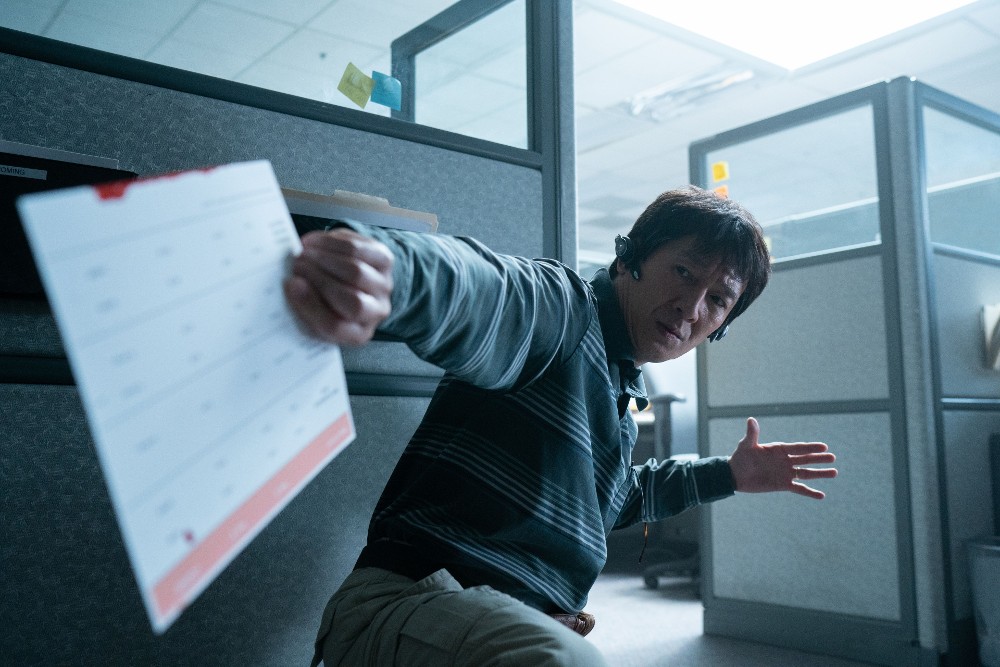
Everything Everywhere All at Once, the second feature film from Dan Kwan and Daniel Scheinert, who are collectively known as Daniels, has been making waves since it first premiered at the SXSW Film Festival in March.
The absurdist action-comedy stars Michelle Yeoh as Evelyn Wang, a laundromat owner whose life is slowly unraveling, as her husband, Waymond (Ke Huy Quan), wants a divorce, she’s at odds with her daughter, Joy (Stephanie Hsu), and her business is being audited by the IRS. So it’s not the best time for Evelyn to discover that she is part of a greater multiverse that’s about to be destroyed by a vengeful despot known as “Jobu Tupaki.” Evelyn is the only one who can stop this imminent destruction by tapping into alternate versions of herself.
The crafts work on display in Everything Everywhere is simply fantastic, and short of speaking with Daniels themselves, the person who can probably best speak to the impressive below-the-line contributions on this A24 film is Cinematographer Larkin Seiple, who shot Daniels’ previous film, Swiss Army Man, as well as many of their earlier music videos.
Below the Line hopped on Zoom with Seiple several weeks ago and he explained how the Daniels made it a bit easier to shoot their more complicated second feature, even with COVID forcing production to shutter before filming had finished. I hope you enjoy our chat below, just in case some version of you in an alternate timeline did not.
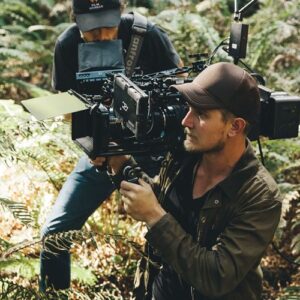
Below the Line: I know you previously shot Swiss Army Man for Daniels, but you guys go back even further than that, right?
Larkin Seiple: Yeah, I’ve shot with the Daniels basically for the past decade. We started doing a lot of music videos and some very, very silly short films, and I was lucky enough to do their very first film, which was “Swissy.”
BTL: You’ve worked your way up through the camera side of things, but you’ve also done a lot of music videos as a DP, so what was the first video you did with Daniels?
Seiple: The first video we did was for Foster the People, in which the band is playing the concert and they die, and the label decides to reanimate them and keep the corpses alive and they build them into electronic puppets. Then they become a bigger hit, so they start making them do choreographed dance moves. It was a very dark take on fame and manipulation. It was wild. We were shooting, like, 60 to 70 setups a day with two cameras. It was a breakneck pace, and if we didn’t move fast enough, I’d look out the corner of my eye and one of the Daniels would have a 5D sneaking in another angle. So the goal for me and my team was to not let the Daniels shoot on a shitty camera for additional footage.
BTL: Do they normally do that? Are they the type of directors who always have cameras on them and are shooting things?
Seiple: Only back then, because back then, they were used to being really scrappy and just trying to get what they could because time was so valuable that they wanted to try to get as many little pieces so they could have fun in the edit. But not the case anymore. Now, it’s much more streamlined, and this film is actually very different. There are a lot of very small one-ers of “How can we do this scene with as few shots as possible?” which I think adds to some of the elegance, especially in the earlier scenes, but also, it helped us make our days in a different manner. If we can do it in one shot, we can get out of here in half an hour.
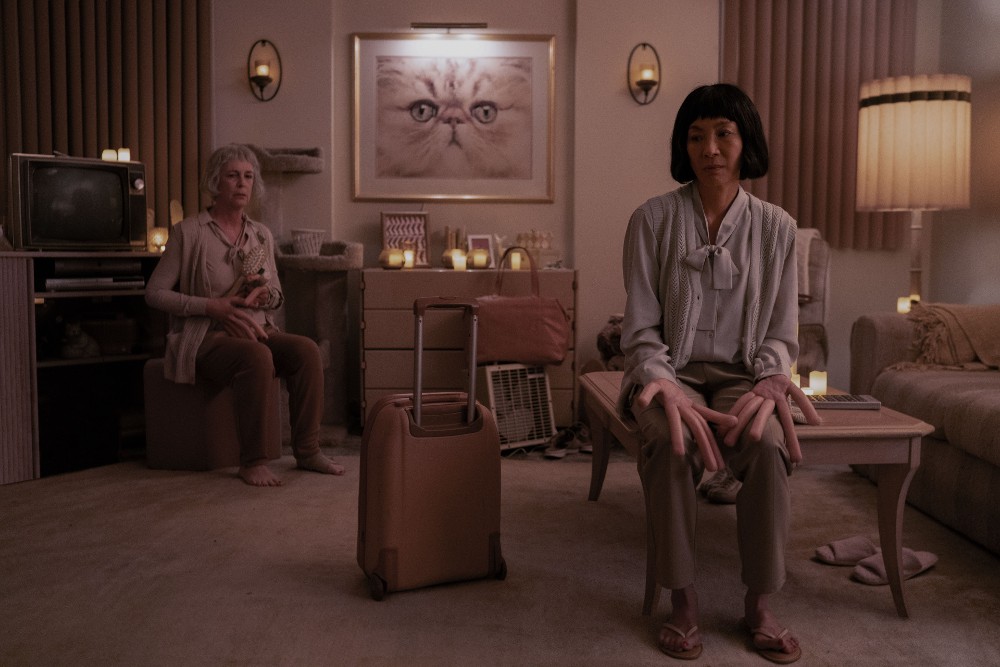
BTL: That Foster the People video sounds like it could be a full-length movie in itself, so I’m going to have to look out for that one.
Seiple: I think their whole gimmick is, ‘as much story as possible in the shortest time as possible.’ That’s what I’ve always loved about their work. Anything you watch, so much happens that you want to watch it again. Like, that’s kind of always been their gag, if you will.
BTL: That said, since you’ve worked with them for so long, did you know about Everything Everywhere early on, even before they’d finished writing the script, even if it was just a general idea at the time?
Seiple: I’m trying to remember what it was, but they were trying to describe universe jumping, and how there’s like a universe where you go left instead of right, but there’s also a universe where you can use a cat as a nun-chuck. That was the very first pitch I heard, and I’m like, “Yeah, I guess there’s a universe where you can do that.” That was their initial take of “That how far we want to push it” to like become, like, beyond absurd. That was one of the very first things we started talking about, and then they would always tease: “There’s a whole fight with a fanny pack. Like how many different ways can we use a fanny pack as a weapon?” which devolved into us doing very dumb things in their office, just messing around, like how far can we push the fanny pack? And I think we’ve maximized it, too.
BTL: I don’t know who handled the props on this movie, but they definitely had their work cut out for them.
Seiple: Yes, just anything involving the Alphaverse was a lot. That’s my favorite prop in the movie. Waymond is wearing oak leaves with LEDs built into them, and when I first saw it, I was like, ‘This is too stupid,’ but then he put them on, and I was like, ‘It’s so stupid but also somewhat cool in the worst possible way.’ We kind of fell in love with it. A lot of the props in this film are like, ‘Okay, how are we going to make this serious?’ Even down to the monkey scene from 2001 with the hot dog fingers. We really tried to make that feel authentic to the original film because of how dumb it was. We really went for it. I think that’s part of their gag as well, is trying really hard to make something very stupid feel very real.
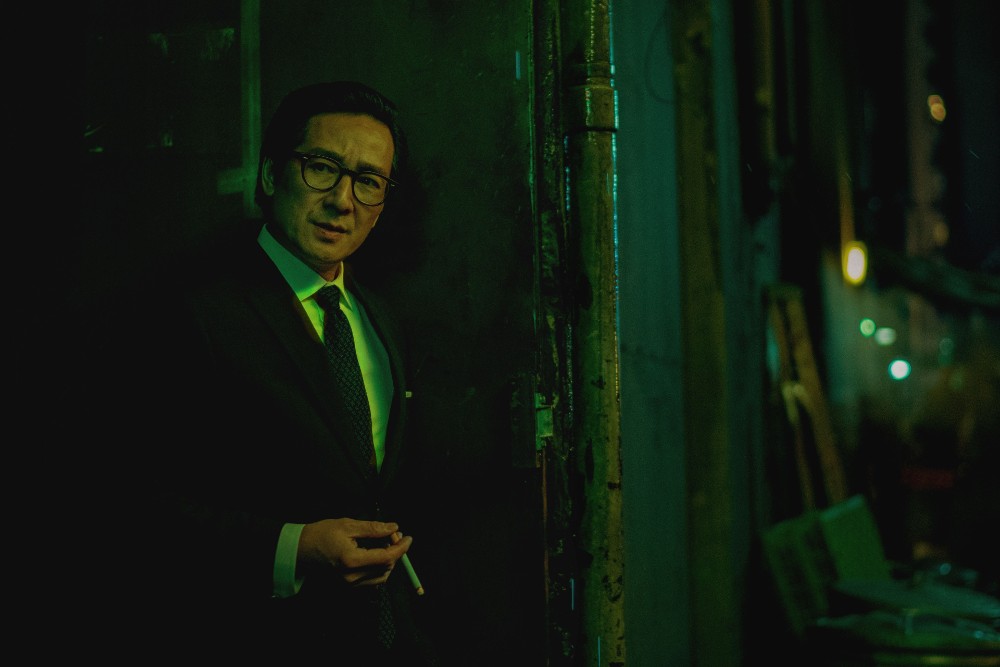
BTL: I feel like there are a lot of references in this movie, including a few scenes that looked deliberately like Wong Kar-wai, so are you guys talking about these movie references while preparing to shoot this?
Seiple: There are a lot of references. Every time we went to a universe that was a reference, it wasn’t necessarily a specific film. So, there is a reference to the Wong Kar-wai universe. In the Mood for Love, we followed really heavily with wardrobe and hair and makeup, but the look for that universe is just kind of like an amalgam of all Wong Kar-wai’s work. It’s actually very rich and colorful in green and yellow, and In the Mood for Love is actually not that. In the Mood for Love is actually very clean photography almost. We kind of just fed on our memories. Fallen Angels is my favorite film by him, and I kind of stole some of the colorwork from that and pushed it into that universe. Originally, the hot dog universe was going to be based on Todd Haynes’ Carol. We started shooting it, and we can’t hold a candle to that film. We have to ditch this reference. We’re not going to be able to remotely make it as beautiful as that, so we started delving into variations on what romantic comedies could be. We actually framed it 2:1 to make it a Netflix aspect ratio, because we wanted to have that be part of a world where this potentially would be a Netflix film. And then, the bagel-versus, there were a bunch of references. When I shot it, it was mainly A Never Ending Story with this weird crystal palace-type vibe.
BTL: Much of the movie takes place in the laundromat and at the IRS office, so how much do you work with the film’s production designer to make sure the sets and locations are someplace where you can shoot how you want to?
Seiple: Kind of like Swiss Army Man, we scouted six months or almost a year before we shot it. On this one, we were scouting basically abandoned buildings or unused buildings in the LA area. We found this old, not abandoned, but it was like a mortgage lending firm that went down in the last recession, and it was just kind of there. They had that weird atrium, and at first, it was too daunting. We just said, “No, it’s too big.” And then we came back two months later, and we’re like, I think we can do it. Our production designer was like, “Okay, but we have to only dress to the frame. So if it’s off-camera, there’s nothing there, or it’s gonna look terrible.”
He did a wonderful job basically doing production design based on resolution. The closer you got to the camera, it looked amazing. If you were 30-feet away from the camera, it was just paper computer monitors or a pasted face onto something. It was very, very clever production design for the budget. The benefit of shooting almost all the movies set in that building. We built the sets inside of that building — the apartment set is actually shot in the cafeteria of the building. It was kind of a goofy area [in which] to shoot, but the building allowed us to test everything out and try things.
The script was written with this abstract concept of an office building, and so we would then go around the building. The final sequence with the staircase and her walking up the stairs to get her daughter? That wasn’t in the script. That atrium is so bizarre, it felt so old-school 1980s action film, almost like a mall in a way that we were like, “What if we made her journey vertical, as opposed to her pushing through people she has to get up these stairs and get to her daughter at the very top?” We just kind of evolved it around that. We found old sets from previous shows that we borrowed because they just left them there. There’s the dominatrix office space of the sign-spinning fight. That was just an old set that we repurposed, and built in our own lighting. The elevator was already there. The elevator was actually a set that could move around, so we just moved from one end of the building to another. Being able to shoot and prep in the same place allowed us to pull this off because there’s so much we had to figure out before we started shooting and while we were shooting.
BTL: I’m amazed there were still sets from other shows that you could reuse because I always assumed everything is broken down and put into storage. But it must be cool to have a building where sets can be used over and over like that.
Seiple: They do have a place like that, and we did reuse some sets. There’s basically set recycling that will keep set walls and things like that for you to repurpose. Film production is hands down not the most wasteful industry, but we go through a lot of material, and we throw it right in the dumpster because no one wants to figure out how to properly dispose of it.
BTL: That building you found is pretty amazing, as I’ve been in office buildings with similarly weird geography. There’s a lot of action in the movie, so were you working with a 2nd unit or a stunt choreographer who was involved with how to place the cameras so no one got hurt?
Seiple: No, we didn’t really shoot any second unit on this. All the action was first unit, we worked directly with the choreographers, Andy and Brian Le, these two brothers from Orange County that Daniels found on the internet and we were just kind of blown away. They reached out and were like, ‘Do you want to choreograph our film?’ And so, they designed the majority of all the Hong Kong-style fight sequences, and you’ll see them in the film as the two trophy brothers in that fight sequence.
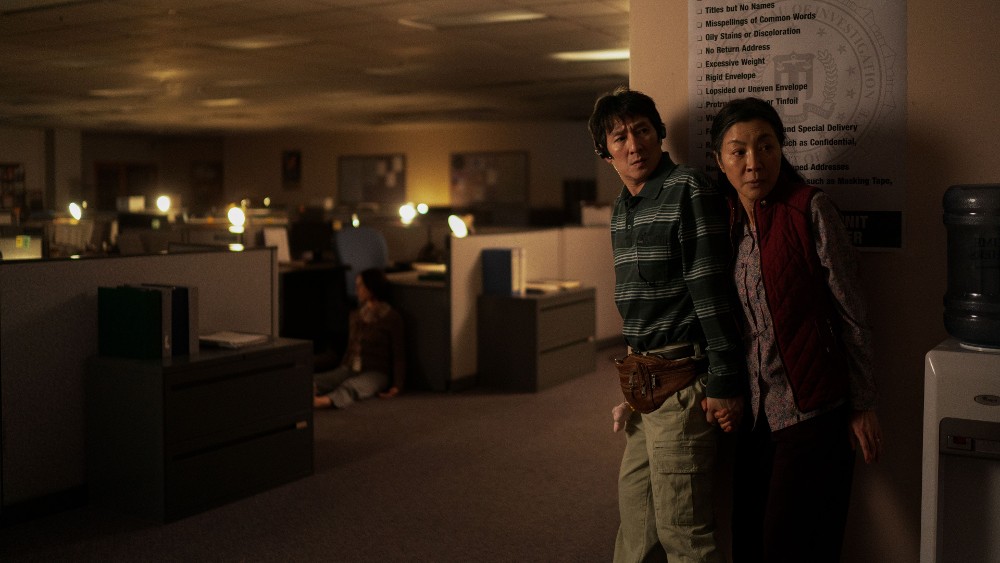
Those two guys got the most bizarre and absurd fight, but they also did like the fanny pack fight and the sign spinner fight they developed. They basically did all that wonderful choreography based on old films that Michelle had done and Jackie had done. The only time we did second unit is we would shoot something, we’d move on, and the next day, we would be like, ‘Oh, crap, we need to get a shot of Michelle putting her shoes on wrong.’ The B-camera would run back with our stand-in… we had two stand-ins for Michelle, and we would just steal a stand-in and have her go and shoot that shot. We would just kind of watch it over monitors. Again, that was a park of that building. If we messed up or we missed something, we would just send the camera over and shoot that one insert and bring them right back.
BTL: I guess on Swiss Army Man there were also a lot of locations, but they all generally seemed to be in the same area.
Seiple: Swiss Army Man was way harder. It was three cities over 23 days, so we shot in Humboldt, San Francisco, and L.A., and they all had wirework, explosions, bears, and water-work. They put us through the wringer on that, and then the last week we did it with literally almost no crew. I had a gaffer and a key grip in the forest with me, but I had no lights or bounces, so they were just hanging out, helping move equipment, and we just spent a week in the most beautiful forests in the US… dragging a corpse around.
BTL: Now did you actually finish shooting this right before COVID at the beginning of 2020?
Seiple: Nope. It was a 38-day shoot, and we stopped on Day 37. It was a Friday, and we had one or two days of greenscreen left, and that Friday, at the meeting of the day, we were like, ‘Alright, I guess we’re not going to see everyone for a while.’ Actually, the last day we shot was the “Wong Kar-wai verse,” which is a really beautiful but bittersweet ending, because we literally ended in the rain, which is pretty rare in LA, when they’re having their final moment. The reshoots were more absurd because Michelle was in Paris, and so we had to do all of these green screen fight sequences of highly-interactive lighting. We had to basically shoot them here in LA on a stage with a stand-in, record that, and then send that video to Paris, and then they had to rebuild our exact lighting scheme on a green screen there. And then we worked here over Zoom from midnight to 8 AM with Michelle in Paris, going through the whole motions of it. There’s a whole scene of her and Waymond in her van, and he’s talking about divorce. Michelle’s not there. She was in Paris for that whole sequence, and we just green-screened her in for that shot, just because that was the only way we could do it.
BTL: Were there a lot more visual effects needed for this than some might imagine just from having to do stuff during the pandemic to finish the movie?
Seiple: Yeah, there are some crazy visual effects that no one will ever notice. There’s like a whole sequence where Jamie Lee Curtis‘ character is in it. In the hallway scene where Jobu and Evelyn meet for the first time, there’s a bunch of weird crazy lighting. Originally, Deirdre was in it, but the scene was too long, and the only way to shorten it was to get rid of Deirdre’s part of it. They had to roto her out of every shot, which is really painful, but when you watch the film, you would never know another human being is next to Jobu the whole time.
Everything Everywhere All at Once is now playing in theaters. Look for more below-the-line interviews with Daniels’ team very soon.





